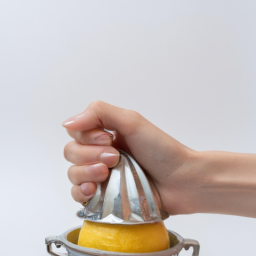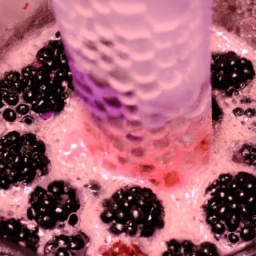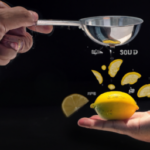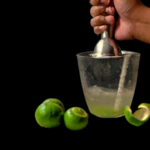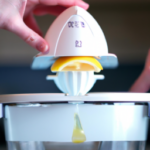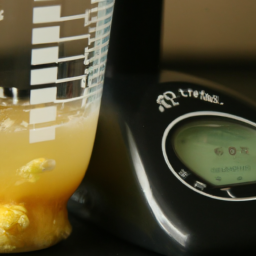I often need fresh lemon juice in my cooking and baking endeavors. While it is possible to manually squeeze lemons, using a juicer can make the process quicker and easier.
In this article, I’ll be sharing my tips and tricks for how to juice a lemon with a juicer.
Firstly, it’s important to choose the right type of juicer for the job. There are two main types of juicers: centrifugal and masticating. Centrifugal juicers are more commonly found in households and use high-speed spinning to extract juice quickly. Masticating juicers, on the other hand, use a slower, grinding motion to extract juice, which can produce a higher yield and preserve more nutrients.
For juicing lemons, either type of juicer will work, but a centrifugal juicer may be more convenient for smaller quantities.
Key Takeaways
- Choose the right type of juicer for your needs, whether it be centrifugal, masticating, or citrus press.
- Prepare the lemon by washing it thoroughly and cutting it into thin slices or wedges. Rolling it on a hard surface and microwaving for 20 seconds can increase juice yield.
- Strain the juice to remove pulp and seeds, and label and date the container for future use. Properly clean the juicer after use to prevent bacteria growth.
- Store lemon juice in the refrigerator for up to 5 days in a glass jar or airtight container, or freeze it in an ice cube tray for up to 6 months. When cleaning the juicer, use warm soapy water and a soft-bristled brush, and avoid abrasive cleaners or tools.
Types of Juicers
I love making fresh juices at home, and there are a few different types of juicers to choose from. Electric juicers are great for making large batches quickly, while manual juicers are perfect for smaller quantities and require a bit more effort.
Citrus presses are specifically designed for juicing lemons, limes, and oranges, and they’re a must-have for any kitchen.
Electric Juicers
Get ready to save time and effort with an electric juicer, which makes juicing lemons a breeze! Electric juicers are designed to extract juice from fruits quickly and efficiently, which is why they’re perfect for juicing lemons.
They come in various sizes and models, but all electric juicers have one thing in common: they require proper maintenance to function effectively. To keep your electric juicer in good condition, clean it regularly after use. Wipe down all parts with a damp cloth, and make sure to remove any pulp or seeds that may have accumulated inside.
Additionally, electric juicers can be used to juice other citrus fruits such as limes and oranges, so you can get the most out of your investment. With an electric juicer, you can enjoy fresh lemon juice without the hassle of manual juicing.
Moving on to manual juicers…
Manual Juicers
Using a manual juicer can provide a more hands-on and intimate experience with your citrus fruits, allowing you to feel the texture and aroma of the fruit as you extract its delicious nectar. Manual juicers come in two main types: handheld and countertop. Handheld juicers are more portable and easier to store, making them a great option for those with limited kitchen space. Countertop juicers, on the other hand, are more stable and can handle larger quantities of citrus fruits at once.
One of the benefits of using a manual juicer over an electric one is the control it gives you over the juicing process. With a manual juicer, you can adjust the pressure and speed at which you juice the fruit, resulting in a more customized juice that meets your personal taste preferences. Additionally, manual juicers are typically easier to clean and maintain than their electric counterparts, making them a more practical and cost-effective option in the long run. As we move into the next section about citrus presses, it’s important to note that manual juicers come in many different shapes and sizes, each with their own unique advantages and disadvantages.
Citrus Presses
When choosing a citrus press, you’ll want to consider the size of the press and the amount of citrus fruit you plan to juice at once. Citrus presses come in both hand held and countertop varieties, each with their own benefits.
Here are four factors to consider when deciding which type of citrus press to use:
-
Hand held presses are smaller and more portable, making them perfect for travel or small kitchens.
-
Countertop presses are larger and can juice larger quantities of citrus at once, making them ideal for entertaining or larger families.
-
Hand held presses require more physical effort to use, but they’re also more affordable.
-
Countertop presses are more expensive, but they’re also more efficient and produce more juice per fruit.
Using a citrus press has many benefits, including getting more juice out of each fruit and reducing hand fatigue. When compared to manual juicers, citrus presses are also generally easier to clean and produce less waste.
When choosing between a hand held and countertop press, it ultimately comes down to personal preference and the specific needs of your household.
Now that you know about citrus presses, let’s move on to choosing the right lemons for juicing.
Choosing the Right Lemons
To ensure the best juice yield, it’s important to choose quality, ripe lemons for juicing. When selecting lemons, look for those that are plump, have a bright yellow color, and have a slightly soft texture when gently squeezed. Avoid lemons that are hard or have a greenish tint, as they are not yet fully ripe and will produce less juice.
It’s also important to properly store your lemons before juicing. Keep them in a cool, dry place away from direct sunlight and moisture to prevent them from spoiling. You can also prolong their freshness by placing them in a plastic bag and storing them in the refrigerator.
Once you have selected and stored your lemons, it’s time to move on to preparing them for juicing.
Preparing the Lemon
Before juicing, it’s crucial to properly prepare your lemon by washing it thoroughly with soap and water to remove any dirt or bacteria. Once the lemon has been washed, dry it with a towel before cutting it. This will make it easier to handle and prevent any slipping accidents.
To prepare the lemon for juicing, start by removing any seeds that may be present. Cut the lemon in half and use a small spoon or fork to scoop out the seeds. After removing the seeds, cut the lemon into smaller pieces that will fit into your juicer. It’s important to note that the cutting technique used can affect the amount of juice extracted. To get the most juice out of your lemon, cut it into thin slices or wedges. With the lemon now prepped and ready, it’s time to move on to using the juicer.
Using the Juicer
Okay, so now that we’ve got our lemons cleaned and ready to go, it’s time to talk about using the juicer.
There are three main types of juicers to choose from: electric juicers, manual juicers, and citrus presses. Each has its own advantages and disadvantages, so it’s important to choose the right one for your needs.
Let’s take a closer look at each type so you can decide which one is best for you.
Electric Juicers
You might think that electric juicers are too expensive, but let me tell you, they’re worth the investment if you need to juice a lot of lemons.
Electric juicers can save you time and effort. Unlike manual juicers, where you have to manually squeeze the lemons, with an electric juicer, you can juice lemons efficiently and quickly, without worrying about getting tired or sore from all the squeezing.
Another advantage of using an electric juicer is the cleaning maintenance. Most electric juicers have detachable parts that can be easily cleaned with soap and water. Some juicers even have dishwasher-safe parts, making cleaning even easier.
Plus, you don’t have to worry about getting lemon juice all over your hands or clothes, as the juicer will catch all the juice for you. However, if you prefer a more hands-on approach or don’t want to invest in an electric juicer, manual juicers are a great option.
Manual Juicers
If you want a more intimate and hands-on experience with your juicing process, a manual juicer could be just what you’re looking for. Manual juicers come in two main types: handheld and countertop.
Handheld juicers are small and portable, making them perfect for juicing on the go or for small kitchens with limited counter space. Countertop juicers, on the other hand, are larger and more stable, making them ideal for juicing larger quantities of fruits and vegetables.
There are many benefits to using a manual juicer over an electric one. First and foremost, manual juicers are much quieter than electric juicers, which can be a major plus if you’re juicing early in the morning or late at night when others are sleeping. Additionally, manual juicers are much easier to clean than electric juicers, as they typically have fewer parts and are less prone to clogging.
Overall, if you’re looking for a more hands-on and personalized juicing experience, a manual juicer may be the perfect option for you.
When it comes to juicing citrus fruits, a citrus press may be your best bet.
Citrus Presses
Moving on from manual juicers, let’s discuss the benefits of using a citrus press for juicing lemons. Citrus presses are electric juicers designed specifically for citrus fruits like lemons, limes, and oranges. They’re easy to use and can extract a large amount of juice in a short amount of time.
Cleaning citrus presses is also relatively easy. You can simply rinse the parts with warm water and soap or put them in the dishwasher. Some citrus presses even have removable parts that make cleaning even easier.
The benefits of using a citrus press for juicing include faster juicing times, less mess, and more juice extracted from each fruit. With a citrus press, you can easily get all the juice out of your lemons without having to put in as much effort as you would with a manual juicer.
Now that we’ve covered the benefits of using a citrus press for juicing, let’s move on to some tips for getting the most juice out of your lemons.
Tips for Getting the Most Juice
To maximize your lemon juice yield, firmly roll the lemon on a hard surface before cutting it. This releases the juices and makes it easier to extract every last drop.
Another juicing hack is to microwave the lemon for about 20 seconds before juicing it. This softens the fruit and makes it easier to extract more juice.
When it comes to lemon squeezing techniques, it’s important to use a citrus juicer that is designed for lemons. Make sure the fruit is cut in half and placed cut-side down on the juicer. Apply firm pressure and twist the juicer to extract the juice.
Once you’ve juiced all of your lemons, it’s time to strain the juice to remove any pulp or seeds.
Straining the Juice
Now that you know how to get the most juice out of your lemon, it’s time to strain the juice. Straining the juice is an important step in the process as it removes any pulp or seeds that may have made their way into the juice.
There are a few straining techniques you can use, but the most common one is to use a fine-mesh strainer. Place the strainer over a bowl or measuring cup and pour the lemon juice through it. Gently press the pulp against the strainer with a spoon to extract as much juice as possible.
Keep in mind that the pulp contains some of the lemon’s flavor and nutrients, so if you prefer pulp-free juice, you may want to skip this step. However, if you like the added texture and taste of pulp in your juice, you can save it and add it back in later.
Now that you have strained your lemon juice, it’s important to store it properly to ensure its freshness and flavor.
Storing Lemon Juice
Don’t let your hard work go to waste! Properly storing your freshly squeezed lemon juice will ensure its flavor and freshness for future use. Here are some tips to help you preserve the freshness of your lemon juice:
-
Refrigerate: Lemon juice can be stored in the refrigerator for up to 5 days. Make sure to store it in a glass jar or airtight container to prevent any contamination.
-
Freezing options: If you don’t plan on using your lemon juice within 5 days, freezing is a great option. Pour the juice into an ice cube tray and freeze. Once frozen, transfer the cubes to a freezer-safe container or bag. Frozen lemon juice can last up to 6 months.
-
Label and date: Whether you refrigerate or freeze your lemon juice, it’s important to label and date the container. This will help you keep track of the freshness of your lemon juice and prevent any confusion.
Now that you know how to store your lemon juice properly, it’s time to move on to cleaning the juicer.
Cleaning the Juicer
After enjoying a refreshing glass of lemonade, it’s important to give your citrus juicer a good cleaning to prevent any buildup or bacteria growth. Effective cleaning is key to ensuring that your juicer remains in good working condition and that your freshly squeezed lemon juice is safe to consume.
To begin the cleaning process, I start by unplugging the juicer and taking it apart. Next, I use warm soapy water and a soft-bristled brush to gently scrub the juicer’s components. I make sure to pay special attention to any hard-to-reach areas, such as the filter, to ensure that all debris is removed.
It’s important to avoid using abrasive cleaners or tools that can scratch or damage the juicer. Once everything has been thoroughly cleaned, I rinse each part with warm water and dry them with a soft cloth. By following these steps, I can ensure that my juicer stays clean and functional, while avoiding any damage that could result from improper cleaning techniques.
Frequently Asked Questions
Can I use a juicer to juice other citrus fruits besides lemons?
Yes, a juicer can be used to juice other citrus fruits like oranges. Using a juicer for citrus fruits offers numerous benefits, such as getting more juice out of the fruit and saving time compared to manual squeezing.
How do I know if the lemon is ripe enough to juice?
To tell if a lemon is ripe enough to juice, I check for a bright yellow color and a slight give when squeezed. The best time to juice is when the lemon is at its juiciest. Juicing techniques can vary, but a juicer is efficient for ripe lemons.
Is there a difference in taste between using a juicer and juicing by hand?
In my experience, there is a slight difference in taste when juicing lemons using a juicer versus by hand. Juicing by hand can produce a more textured and flavorful juice, while a juicer can create a smoother and more consistent juice. However, both techniques can yield delicious results.
How much juice can I expect to get from one lemon using a juicer?
I can maximize juice yield from one lemon by using a handheld citrus reamer or rolling it before slicing. However, using a juicer can yield up to 2-3 ounces of juice per lemon.
Can I freeze the lemon juice for later use?
Yes, I freeze lemon juice all the time. It’s a great way to preserve the juice for later use. I usually pour the juice into ice cube trays and freeze them. Then I transfer the cubes to a freezer bag. It’s perfect for recipes that require a small amount of fresh lemon juice.
Conclusion
So there you have it, folks! Juicing a lemon with a juicer is a quick and efficient way to get the most juice out of your lemons.
Remember to choose the right type of juicer for your needs, select fresh and ripe lemons, and prepare them properly for juicing. Using a juicer is a simple process, but there are a few tips and tricks that can help you get the most juice out of your lemons.
Don’t forget to strain the juice to remove any pulp or seeds, and store it properly in an airtight container. And, of course, always clean your juicer thoroughly after use to keep it in top condition.
Happy juicing!
Ilana has been a vegan for over 10 years. She originally made the switch for health reasons, but soon found herself becoming more and more passionate about the ethical and environmental implications of a vegan lifestyle. Ilana is the author of The Graceful Kitchen, a blog all about veganism. She loves to cook up delicious and nutritious vegan meals, and share her recipes with others who are interested in leading a cruelty-free life. Ilana is also a strong advocate for using whole foods as the foundation of a healthy diet, and believes that going vegan is one of the best ways to achieve this.
